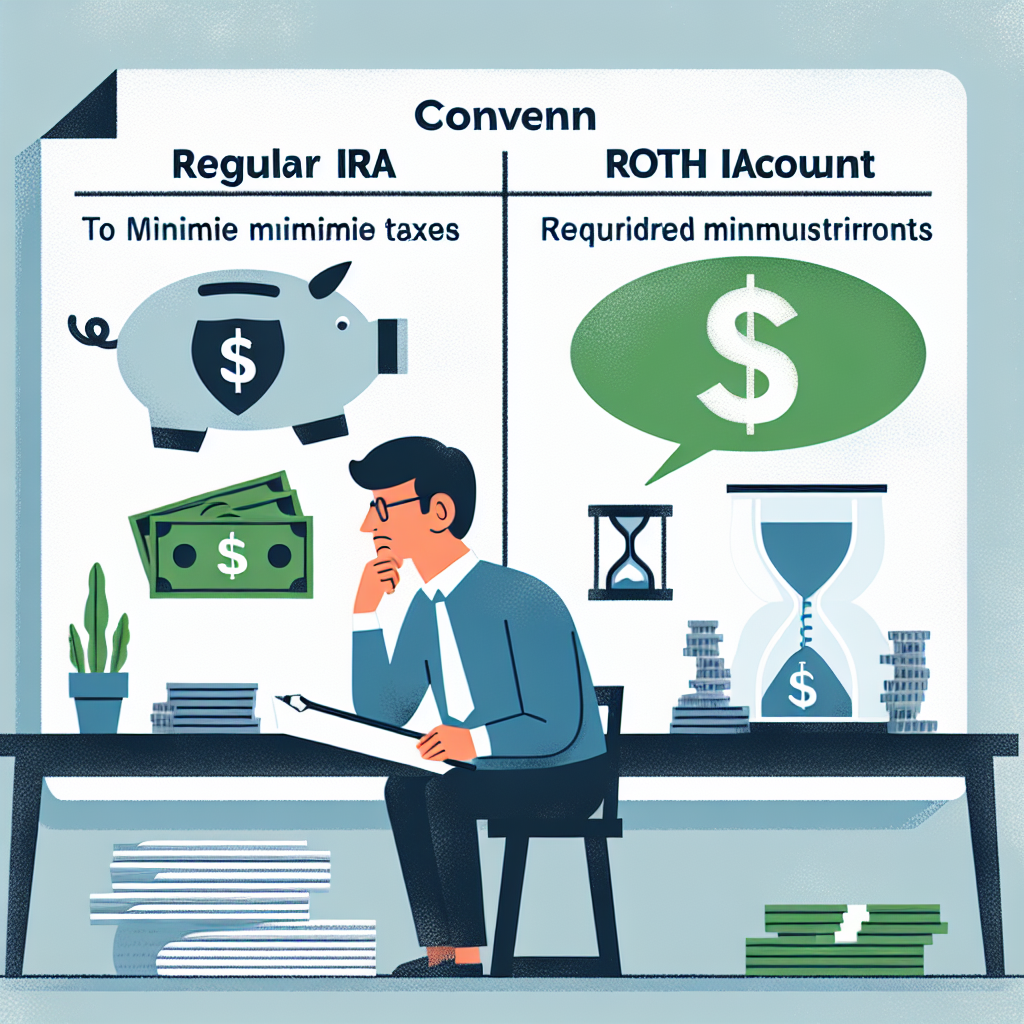“Strategize Your Retirement: Convert to a Roth IRA for Tax Efficiency and RMD Control.”
Introduction
Converting a traditional IRA to a Roth IRA is a strategic financial decision that can have significant implications for your retirement planning, particularly when considering tax liabilities and required minimum distributions (RMDs). At age 64, you are approaching the age where RMDs from a traditional IRA become mandatory, starting at 73, which can increase your taxable income and potentially push you into a higher tax bracket. By converting your $650,000 IRA to a Roth IRA, you may be able to minimize future tax burdens, as Roth IRAs do not require RMDs during the account holder’s lifetime and qualified withdrawals are tax-free. However, the conversion itself is a taxable event, and it is crucial to evaluate whether the immediate tax cost of conversion is outweighed by the long-term benefits of tax-free growth and withdrawals. This decision should be carefully considered in the context of your overall financial situation, tax bracket, and retirement goals.
Benefits Of Converting A Traditional IRA To A Roth IRA At Age 64
Converting a traditional IRA to a Roth IRA at the age of 64 can be a strategic financial decision, particularly for those looking to minimize taxes and required minimum distributions (RMDs) in retirement. As individuals approach retirement, the prospect of managing tax liabilities becomes increasingly significant. One of the primary benefits of converting a traditional IRA to a Roth IRA is the potential for tax-free growth. Unlike traditional IRAs, where withdrawals are taxed as ordinary income, Roth IRAs allow for tax-free withdrawals, provided certain conditions are met. This can be particularly advantageous for individuals who anticipate being in a higher tax bracket in the future or who wish to avoid the impact of RMDs on their taxable income.
Moreover, converting to a Roth IRA at 64 allows individuals to pay taxes on the conversion amount at their current tax rate, which may be lower than future rates. This is especially relevant given the uncertainty surrounding future tax legislation. By paying taxes now, individuals can potentially shield themselves from higher tax rates later, thereby preserving more of their retirement savings. Additionally, Roth IRAs do not require RMDs during the account holder’s lifetime, offering greater flexibility in managing retirement income. This can be particularly beneficial for those who do not need to draw on their retirement savings immediately and prefer to let their investments grow.
Furthermore, a Roth conversion can be a valuable estate planning tool. Since Roth IRAs are not subject to RMDs, account holders can leave the entire balance to their heirs, who can then benefit from tax-free withdrawals. This can significantly enhance the financial legacy left to beneficiaries, providing them with a more substantial inheritance. Additionally, the absence of RMDs allows for more strategic withdrawal planning, enabling individuals to better manage their taxable income and potentially reduce the impact on Social Security benefits and Medicare premiums.
However, it is important to consider the potential drawbacks of a Roth conversion. The immediate tax liability incurred during the conversion process can be substantial, particularly for a $650,000 IRA. It is crucial to ensure that funds outside of the IRA are available to cover the tax bill, as using IRA funds to pay taxes can diminish the benefits of the conversion. Additionally, individuals should carefully evaluate their current and projected tax brackets to determine if a conversion is financially advantageous.
In conclusion, converting a traditional IRA to a Roth IRA at age 64 can offer significant benefits, including tax-free growth, elimination of RMDs, and enhanced estate planning opportunities. However, it is essential to weigh these advantages against the immediate tax implications and consider one’s overall financial situation. Consulting with a financial advisor or tax professional can provide valuable insights and help individuals make informed decisions tailored to their unique circumstances. By carefully evaluating the potential benefits and drawbacks, individuals can determine whether a Roth conversion aligns with their long-term financial goals and retirement plans.
Understanding The Tax Implications Of A $650k IRA Conversion
Converting a $650,000 Individual Retirement Account (IRA) to a Roth IRA at the age of 64 is a decision that requires careful consideration of the tax implications and future financial benefits. The primary motivation for such a conversion often revolves around minimizing taxes and reducing the burden of Required Minimum Distributions (RMDs) in the future. To understand the tax implications of this conversion, it is essential to explore the immediate tax consequences, the potential for tax-free growth, and the impact on RMDs.
Initially, converting a traditional IRA to a Roth IRA involves paying taxes on the converted amount. This is because contributions to a traditional IRA are typically made with pre-tax dollars, meaning taxes have not yet been paid on these funds. When converting to a Roth IRA, the entire converted amount is considered taxable income for the year in which the conversion occurs. Therefore, converting a $650,000 IRA could significantly increase your taxable income, potentially pushing you into a higher tax bracket. It is crucial to evaluate whether you have sufficient funds outside of the IRA to cover the tax liability, as using IRA funds to pay taxes could diminish the benefits of the conversion.
Despite the immediate tax burden, a Roth IRA offers the advantage of tax-free growth. Once the conversion is complete and taxes are paid, any future growth in the Roth IRA is not subject to taxation, provided certain conditions are met. This can be particularly beneficial if you anticipate being in a higher tax bracket in retirement or if you expect significant growth in your investments. Moreover, Roth IRAs do not have RMDs during the account holder’s lifetime, allowing the funds to grow undisturbed for a longer period. This feature can be especially advantageous for those who do not need to access their retirement funds immediately and wish to leave a larger inheritance to their beneficiaries.
Furthermore, considering the impact on RMDs is essential when evaluating a Roth conversion. Traditional IRAs require account holders to begin taking RMDs at age 73, which can increase taxable income and potentially affect other aspects of financial planning, such as Medicare premiums and Social Security taxation. By converting to a Roth IRA, you can eliminate the need for RMDs, thereby maintaining greater control over your taxable income in retirement. This flexibility can be particularly appealing for individuals who wish to manage their tax liabilities strategically.
However, it is important to consider the timing of the conversion. Converting at age 64 provides a window of opportunity before RMDs begin, allowing for potential tax savings over the long term. Additionally, spreading the conversion over several years may help mitigate the tax impact by keeping you in a lower tax bracket each year. Consulting with a financial advisor or tax professional can provide personalized guidance based on your unique financial situation and goals.
In conclusion, converting a $650,000 IRA to a Roth IRA at age 64 involves weighing the immediate tax implications against the long-term benefits of tax-free growth and the elimination of RMDs. While the decision is complex and requires careful analysis, understanding these factors can help you make an informed choice that aligns with your financial objectives and retirement plans.
How Roth IRA Conversions Can Minimize Required Minimum Distributions
Converting a traditional IRA to a Roth IRA is a strategic financial decision that can significantly impact one’s retirement planning, particularly when considering the implications of required minimum distributions (RMDs). For individuals aged 64 with a substantial IRA balance, such as $650,000, the question of whether to convert to a Roth IRA is crucial in minimizing future tax liabilities and managing RMDs effectively.
Traditional IRAs require account holders to begin taking RMDs starting at age 73, as per the SECURE Act 2.0. These mandatory withdrawals are taxed as ordinary income, potentially pushing retirees into higher tax brackets and affecting their overall tax strategy. In contrast, Roth IRAs do not have RMDs during the account holder’s lifetime, allowing the funds to grow tax-free for a longer period. This feature makes Roth IRAs an attractive option for those looking to minimize taxable income in retirement.
One of the primary benefits of converting a traditional IRA to a Roth IRA is the potential for tax-free growth. By paying taxes on the converted amount now, account holders can avoid paying taxes on future withdrawals, assuming they meet the necessary conditions. This can be particularly advantageous if one anticipates being in a higher tax bracket in the future or if tax rates are expected to rise. Moreover, converting to a Roth IRA can provide greater flexibility in retirement planning, as it allows individuals to manage their taxable income more effectively by choosing when and how much to withdraw.
However, the decision to convert should not be taken lightly, as it involves paying taxes on the converted amount in the year of conversion. For someone with a $650,000 IRA, this could result in a significant tax bill, potentially pushing them into a higher tax bracket for that year. Therefore, it is essential to consider one’s current and projected future tax situation. Utilizing a phased conversion strategy, where the conversion is spread over several years, can help mitigate the immediate tax impact and prevent bracket creep.
Additionally, it is important to consider the source of funds for paying the conversion taxes. Ideally, these taxes should be paid from sources outside the IRA to maximize the amount that remains in the Roth IRA for tax-free growth. Using IRA funds to pay the taxes would reduce the amount converted and diminish the potential benefits of the conversion.
Furthermore, individuals should evaluate their estate planning goals. Roth IRAs can be an effective tool for wealth transfer, as beneficiaries can inherit the account and continue to enjoy tax-free growth, subject to certain distribution rules. This can be particularly beneficial for those who wish to leave a financial legacy for their heirs.
In conclusion, converting a $650,000 traditional IRA to a Roth IRA at age 64 can be a prudent move to minimize taxes and eliminate RMDs, but it requires careful consideration of various factors. By assessing one’s current and future tax situation, employing a phased conversion strategy, and aligning the decision with estate planning objectives, individuals can make an informed choice that aligns with their long-term financial goals. Consulting with a financial advisor or tax professional can provide valuable insights and help navigate the complexities of this decision, ensuring that it aligns with one’s overall retirement strategy.
Evaluating The Long-Term Financial Impact Of A Roth Conversion

When considering the conversion of a $650,000 IRA to a Roth IRA at the age of 64, it is crucial to evaluate the long-term financial impact, particularly in terms of minimizing taxes and required minimum distributions (RMDs). The decision to convert hinges on several factors, including current and future tax rates, the time horizon for the investment, and the individual’s overall financial situation. By understanding these elements, one can make a more informed decision about whether a Roth conversion is beneficial.
Firstly, it is important to consider the tax implications of converting a traditional IRA to a Roth IRA. Converting a $650,000 IRA will result in a significant taxable event, as the entire amount converted is subject to income tax in the year of conversion. Therefore, it is essential to assess whether the current tax rate is lower than what is expected in the future. If an individual anticipates being in a higher tax bracket during retirement, converting to a Roth IRA now could be advantageous, as it allows for tax-free withdrawals later. Conversely, if the current tax rate is higher than what is expected in retirement, it may be more prudent to delay the conversion.
Moreover, the elimination of RMDs is a compelling reason to consider a Roth conversion. Traditional IRAs require account holders to begin taking RMDs at age 73, which can increase taxable income and potentially push individuals into higher tax brackets. By converting to a Roth IRA, one can avoid RMDs altogether, allowing the account to grow tax-free for a longer period. This can be particularly beneficial for those who do not need to access their retirement funds immediately and wish to leave a larger inheritance to their beneficiaries.
In addition to tax considerations, the time horizon for the investment plays a critical role in the decision-making process. A longer time horizon allows for more significant growth potential within the Roth IRA, as the funds can compound tax-free over time. For individuals who expect to live a long life or who wish to pass on their wealth to heirs, the benefits of a Roth conversion may outweigh the immediate tax costs. However, for those with a shorter time horizon or who require access to their funds sooner, the immediate tax burden of conversion may not be justified.
Furthermore, it is essential to evaluate the individual’s overall financial situation, including other sources of retirement income and assets. If the conversion results in a substantial tax liability that depletes other savings or requires the sale of investments, it may not be the most financially sound decision. It is also important to consider the impact on Social Security benefits and Medicare premiums, as increased taxable income from the conversion could lead to higher costs in these areas.
In conclusion, converting a $650,000 IRA to a Roth IRA at age 64 can offer significant long-term financial benefits, particularly in terms of minimizing taxes and eliminating RMDs. However, the decision should be made after careful consideration of current and future tax rates, the time horizon for the investment, and the individual’s overall financial situation. By weighing these factors, one can determine whether a Roth conversion aligns with their long-term financial goals and provides the most advantageous outcome.
Strategies For Managing Taxes During A Roth IRA Conversion
Converting a traditional IRA to a Roth IRA is a strategic financial decision that can have significant implications for your tax situation, especially as you approach retirement. At age 64, with a $650,000 IRA, the decision to convert hinges on several factors, including your current and projected future tax brackets, the potential for tax-free growth, and the impact on required minimum distributions (RMDs). Understanding these elements can help you make an informed choice that aligns with your long-term financial goals.
One of the primary considerations in converting to a Roth IRA is the current tax environment. When you convert a traditional IRA to a Roth IRA, you pay taxes on the converted amount at your current income tax rate. If you anticipate being in a higher tax bracket in the future, either due to changes in tax laws or increased income, converting now could be advantageous. This is because Roth IRAs allow for tax-free withdrawals in retirement, potentially saving you money in the long run. Moreover, with the current tax rates set to expire in 2025, converting now might allow you to take advantage of lower rates before potential increases.
Another significant advantage of a Roth IRA is the elimination of RMDs. Traditional IRAs require you to start taking distributions at age 73, which can increase your taxable income and potentially push you into a higher tax bracket. By converting to a Roth IRA, you can avoid these mandatory withdrawals, giving you more control over your income in retirement. This flexibility can be particularly beneficial if you have other sources of income and wish to minimize your tax liability.
However, the decision to convert should also consider the immediate tax impact. Converting a $650,000 IRA could result in a substantial tax bill, depending on how much you choose to convert each year. To mitigate this, you might consider a partial conversion strategy, spreading the conversion over several years. This approach can help manage the tax burden by keeping you in a lower tax bracket each year, rather than pushing you into a higher bracket with a full conversion.
Additionally, it is essential to evaluate your current financial situation, including your cash flow and liquidity. Paying the taxes on a conversion with funds outside of your IRA is generally recommended, as using IRA funds to pay taxes can diminish the benefits of the conversion. Therefore, having sufficient non-retirement assets to cover the tax liability is crucial.
Furthermore, considering your estate planning goals can also influence your decision. Roth IRAs can be an effective tool for passing wealth to heirs, as they can inherit the account without immediate tax consequences. This can be particularly appealing if you wish to leave a tax-efficient legacy.
In conclusion, converting a $650,000 IRA to a Roth at age 64 can be a prudent strategy to minimize taxes and manage RMDs, but it requires careful consideration of various factors. By evaluating your current and future tax situation, understanding the implications of RMDs, and considering your overall financial and estate planning goals, you can make a decision that best suits your needs. Consulting with a financial advisor or tax professional can provide personalized guidance and ensure that your strategy aligns with your long-term objectives.
Comparing Traditional And Roth IRAs For Retirement Planning
When planning for retirement, understanding the nuances between Traditional and Roth IRAs is crucial, especially when considering the potential benefits of converting a Traditional IRA to a Roth IRA. At the age of 64, with a $650,000 IRA, the decision to convert can significantly impact your financial strategy, particularly in terms of minimizing taxes and Required Minimum Distributions (RMDs). To make an informed decision, it is essential to compare the characteristics and implications of both types of IRAs.
Traditional IRAs offer the advantage of tax-deferred growth, meaning contributions are typically tax-deductible, and taxes on earnings are deferred until withdrawals are made during retirement. This can be beneficial for individuals who expect to be in a lower tax bracket upon retirement. However, Traditional IRAs require account holders to begin taking RMDs at age 73, which can lead to a substantial tax burden if the account has grown significantly. This is where the consideration of converting to a Roth IRA becomes pertinent.
Roth IRAs, on the other hand, are funded with after-tax dollars, meaning contributions are not tax-deductible. However, the primary advantage of a Roth IRA is that qualified withdrawals, including earnings, are tax-free. Additionally, Roth IRAs do not have RMDs during the account holder’s lifetime, allowing for greater flexibility in managing retirement income and potentially reducing the overall tax burden. This feature can be particularly appealing for those who wish to leave a tax-free inheritance to their heirs.
When contemplating a conversion from a Traditional IRA to a Roth IRA, one must consider the immediate tax implications. Converting a $650,000 IRA at age 64 would require paying taxes on the converted amount, which could push the account holder into a higher tax bracket for that year. Therefore, it is crucial to evaluate whether the long-term benefits of tax-free withdrawals and the absence of RMDs outweigh the short-term tax costs. For some, spreading the conversion over several years may be a strategic approach to mitigate the tax impact.
Moreover, the decision to convert should also take into account future tax rate expectations. If you anticipate that tax rates will rise, either due to changes in tax laws or personal income increases, converting to a Roth IRA now could be advantageous. Conversely, if you expect to be in a lower tax bracket in the future, maintaining a Traditional IRA might be more beneficial.
Another factor to consider is the source of funds to pay the conversion taxes. Ideally, these taxes should be paid from sources outside the IRA to maximize the amount that remains invested and continues to grow tax-free. Using IRA funds to pay taxes would reduce the amount converted and potentially diminish the benefits of the conversion.
In conclusion, the decision to convert a $650,000 Traditional IRA to a Roth IRA at age 64 involves a careful analysis of current and future tax implications, retirement income needs, and estate planning goals. By weighing the benefits of tax-free growth and the elimination of RMDs against the immediate tax costs of conversion, individuals can make a strategic choice that aligns with their long-term financial objectives. Consulting with a financial advisor can provide personalized insights and help navigate the complexities of this decision, ensuring that it supports a well-rounded retirement plan.
Timing Considerations For Converting Your IRA To A Roth At 64
When contemplating the conversion of a $650,000 IRA to a Roth IRA at the age of 64, several timing considerations come into play, each with significant implications for minimizing taxes and required minimum distributions (RMDs). The decision to convert hinges on a variety of factors, including current and future tax rates, the potential for tax-free growth, and the impact on retirement income. Understanding these elements is crucial for making an informed decision.
To begin with, one of the primary advantages of converting a traditional IRA to a Roth IRA is the potential for tax-free growth. Unlike traditional IRAs, Roth IRAs allow for tax-free withdrawals in retirement, provided certain conditions are met. This can be particularly beneficial if you anticipate being in a higher tax bracket in the future or if you expect tax rates to rise. By paying taxes on the conversion now, you can potentially avoid higher taxes later, thus preserving more of your retirement savings.
Moreover, converting to a Roth IRA can help manage RMDs. Traditional IRAs require account holders to begin taking RMDs at age 73, which can increase taxable income and potentially push you into a higher tax bracket. By converting to a Roth IRA, you eliminate the need for RMDs, allowing your investments to continue growing tax-free. This can be especially advantageous if you do not need the RMDs for living expenses and prefer to let your investments compound over time.
However, the timing of the conversion is critical. At age 64, you are likely nearing retirement or already retired, which means your income may be lower than during your peak earning years. This could be an opportune time to convert, as the tax liability on the conversion may be reduced. Additionally, spreading the conversion over several years can help manage the tax impact, preventing a large one-time increase in taxable income.
On the other hand, it is essential to consider the impact of the conversion on your current financial situation. Converting a $650,000 IRA in one year could result in a substantial tax bill, potentially outweighing the benefits of future tax-free growth. Therefore, it may be prudent to convert only a portion of the IRA each year, aligning with your tax bracket and financial goals. This strategy allows for greater control over the tax implications and can be adjusted based on changes in tax laws or personal circumstances.
Furthermore, it is important to evaluate the potential impact on other aspects of your financial plan, such as Social Security benefits and Medicare premiums. A significant increase in taxable income due to the conversion could affect the taxation of Social Security benefits and increase Medicare Part B and D premiums. These factors should be carefully weighed against the benefits of the conversion.
In conclusion, converting a $650,000 IRA to a Roth IRA at age 64 requires careful consideration of timing and tax implications. By evaluating current and future tax rates, the potential for tax-free growth, and the impact on RMDs, you can make a more informed decision. Additionally, spreading the conversion over several years and considering the broader financial picture can help optimize the benefits while minimizing potential drawbacks. Consulting with a financial advisor or tax professional can provide personalized guidance tailored to your unique situation, ensuring that your retirement strategy aligns with your long-term financial goals.
Q&A
1. **What are the tax implications of converting a traditional IRA to a Roth IRA?**
Converting a traditional IRA to a Roth IRA requires paying taxes on the converted amount as it is considered taxable income for the year of conversion.
2. **How does converting to a Roth IRA affect Required Minimum Distributions (RMDs)?**
Roth IRAs do not have RMDs during the account owner’s lifetime, potentially reducing taxable income in retirement.
3. **What is the impact of conversion on Social Security benefits taxation?**
The conversion could increase taxable income, potentially subjecting more of your Social Security benefits to taxation.
4. **How might converting to a Roth IRA affect Medicare premiums?**
Higher taxable income from the conversion could increase Medicare Part B and Part D premiums due to Income-Related Monthly Adjustment Amounts (IRMAA).
5. **What are the benefits of a Roth IRA for estate planning?**
Roth IRAs can be passed on to heirs tax-free, and beneficiaries can take distributions without paying income tax, providing tax-efficient wealth transfer.
6. **How does the timing of conversion impact tax liability?**
Converting in a year with lower income or when tax rates are expected to rise in the future can minimize tax liability.
7. **What are the potential long-term benefits of converting to a Roth IRA?**
Long-term benefits include tax-free growth, no RMDs, and potentially lower taxes in retirement, especially if tax rates increase.
Conclusion
Converting a $650k IRA to a Roth IRA at age 64 can be a strategic move to minimize future taxes and Required Minimum Distributions (RMDs), but it depends on several factors. If you expect to be in a higher tax bracket in retirement or anticipate significant RMDs that could push you into a higher bracket, converting now might be beneficial. However, consider the immediate tax implications of the conversion, as it will be taxed as ordinary income. If you have other funds to pay the conversion tax and expect to leave the Roth IRA to heirs, the tax-free growth and withdrawal benefits can be advantageous. Consulting with a financial advisor or tax professional is recommended to evaluate your specific situation and long-term financial goals.




